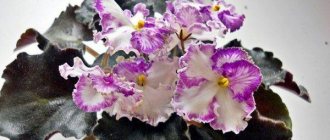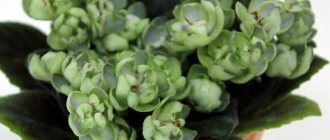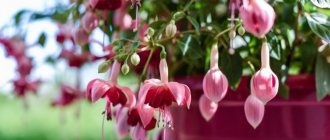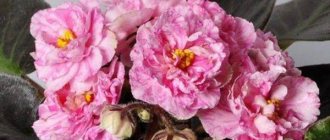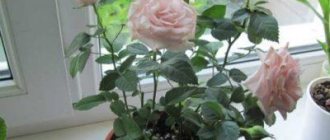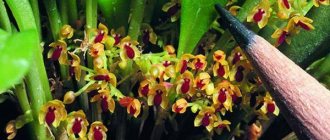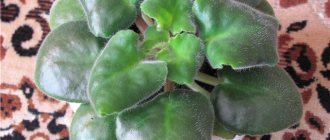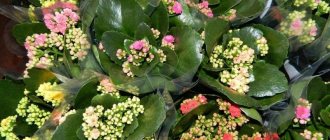What mini violets look like
Bokarneya: home care and popular types
There are 3 known mini varieties: semi-mini violets, miniature and microminiature types.
Mini violet
The diameter of the rosette in half-minis ranges from 15 to 20 cm. If they are transplanted into a larger pot, they will quickly move into the category of standard violets.
The rosette of mini varieties does not exceed 15 cm in diameter. To prevent these varieties from growing, the lower tier of leaves are constantly removed and the flower is replanted.
The diameter of the rosette of microviolets is no more than 8 cm, the length of the leaves is only 0.6-1.2 cm. These little ones are the most demanding to care for. The leaf blades are shaped like a heart or a circle with wavy edges. The central vein at the base of the leaf is thicker and lighter than the other veins. Babies have more leaves than standard violets. Their flowers are no more than 4 cm in diameter.
Reproduction
Propagation of mini Saintpaulias is carried out according to the same principle as standard plants. But there are little secrets here too.
Cuttings
Choose a strong and healthy leaf of “middle” age. If a violet with variegated leaves takes root, then you need to break off the “greener” leaf: the less white, the better.
To exclude fungal diseases, the leaf plate is immersed in a fungicidal solution. Cut the stem with a very sharp tool to a length of 1 cm, let it dry.
Advice! It should be rooted in soil, peat or sphagnum moss, as small leaves begin to rot in water.
The substrate should be loose and low in nutrients. Preparations cannot be used for root crops; they can cause burns to the planting material. Since the cuttings of mini-violets are thinner and more delicate, they are not buried, but planted in the ground, sprinkled with substrate at a height of 0.5-1 cm.
Place the seedling in a greenhouse or plastic bag. Ventilate them periodically. The adaptation of miniature violets to the environment begins just a few weeks after they are separated from the mother leaf.
Stepchildren
Miniature violets grow many stepsons, especially soon after transplanting the plant.
They are left to grow, carefully separated from the mother plant with a needle or toothpick and placed on moist sphagnum moss in a greenhouse or in a transparent container with a lid. Before planting, the moss is watered with Fitosporin.
After Saintpaulia has taken root and reached a size where it is not scary to collect, it is planted for permanent residence with obligatory placement in a plastic bag or greenhouse for 2-3 weeks.
Since the minis immediately sit in permanent containers, and the diameter of the rosettes of these crumbs is much smaller than the width of the pot, the lower leaves lie on the ground. Most likely, they will begin to deteriorate. Therefore, the flower requires:
- Regular inspection;
- And remove the rotting plates.
When the trunk is bare, you just need to pour soil. The root system will increase and the trunk will become stronger.
Description of common varieties
How to replant violets at home
Common varieties of semi-miniature violets are:
- Aca's Happy Star - the flower of this variety is shaped like a large double pink star, with dark burgundy rays radiating from the center.
- Aca's Johnny Redcoats - the variety has a dark lilac flower color, the tips of the petals are white, and the flower petals are velvety.
- Adirondack Moon is a variety with variegated leaves. The inflorescences are double or semi-double white. In the center the petals are yellow and lilac-blue.
Mini flower in hands
Popular among miniviolets are:
Alan's Blue Star is a variety with large blue flowers. This variety is interesting because its petals have small dots of coral color. The shape of the flower resembles a star with wavy edges and a thin white stripe along the edge. The leaves of this variety are small, dark green in color, with teeth along the edge.
- Bahamian Sunset is a variety with a neat rosette of burgundy double flowers and a thin white stripe along the edge.
- Gleeful Elf is a variety with a compact rosette of delicate blue flowers, along the edges of which there is a white-green border. The leaves are light green.
Microvarieties are represented by such varieties as:
- Chantaspring is a violet with a rosette of small yellow bells.
- Rob's Twinkle Blue - blue violet. The rosette of the flower is only 5-6 cm in diameter.
- Child's play - a variety with heart-shaped leaves and white flowers with a lilac shadow on the petals.
Varieties of violets
Miniature trailers
Trailer Saintpaulias include varieties with an elongated stem with several growing points. The bushes of the plant are almost constantly in a state of flowering. Purple trailers are divided into groups according to sheet size:
- 3.8-5 cm - standard;
- 2.5-3.7 cm - miniature seeds;
- 1.3-2.4 cm - miniatures;
- 0.6-1.2 cm - microminiature.
Miniature trailer of Violet.
Trailers can be:
- Ampelous;
- And a bush.
The former have a longer and more flexible trunk. These Saintpaulias are created according to the taste of the owner. To avoid strong thickening, some steps are removed.
Trailer pots are a flat and wide choice, but since mini varieties with a larger container diameter can lose their diminutiveness, several are placed in a large bowl and covered with sphagnum moss, which is kept moist.
Attention! In this case, peat serves as soil for mini-violets, since the earth is constantly acidified.
Breeders Ekaterina Zybinova, Alexey Kuznetsov and Igor Milekhin
Many beautiful mini Saintpaulias are created by our leading breeders. We have selected for you:
- Mini violets from Ekaterina Zybinova;
- Mini violets Milekhin Igor;
- Mini violas Alexey Kuznetsov.
These are varieties such as:
- View of Balchug, I. Milekhin - large pink flowers up to 4 cm and rosettes up to 10 cm, blooms often and profusely;
Violetta Balchug's intuition. - Balchug Yeti, I. Milekhina - blooms with a cap of white flowers with a blue eye;
Purple Balchug Yeti.
- Balchug Dream, I. Milekhina - rather large white flowers with a blue border;
Dream about a purple balchug. - Balchug Mistral, I. Milekhina - large purple flowers, up to 4 cm. Disadvantages: easily adapts to sporty blue flowers; can become a standard when grown in a large pot.;
Violetta Balchug Mistral.
- SK-Volushka, A. Kuznetsova - lavender-white flowers 2.5 cm, self-forming rosette;
Alto SK-Volushka.
- SK-Confiture, A. Kuznetsova - white flowers with a bright pink border 1.5 cm, blooms with a cap;
Purple SK-Confiture.
- SK-Landscape in the Fog, A. Kuznetsova - blooms with large white bells with a blue tint, rosette 8-10 cm;
Violet SK-Landscape in the fog. - Rob's Antique Rose, E. Zybinova - large creamy pink flowers with very wavy edges;
Old Rose Violet Rob. - Honey Berry, E. Zybinova - rather large dark purple double flowers.
Purple honey berry.
Species "Wasp"
Among the variety of mini-Saintpaulia varieties, varieties like “Osa” stand out. In another way they call mini violets Bee. The flower is characterized by completely separate petals, two of which are rolled into a tube, and three, elongated, hang down.
Purple wasp.
The following prominent representatives of this type of violet can be noted:
- Lunar Lily White has snow-white flowers up to 4 cm and a small rosette of tufted leaves;
- PL-Zemfira, L. Pchelovodova is distinguished by large dark purple flowers with wavy edges.
Work with violets for wasps has been going on for a long time, but it has not been possible to develop a wide variety of varieties.
Industrial
As interest in miniature violets grows year after year, more and more of these little beauties are appearing on store shelves and in private collections. Below is a small catalog of miniature violets for you.
You can note such miniature varieties as:
- Eloise of Aki;
Eloise by Violet Aka. - Allegro Charm C;
Allegro C pendant in purple.
- Botswana Beka;
Botswana Violet Beka.
- Great;
Violetta Bellita.
- Boo, men;
Alt Boo Man.
- Dance trail;
Purple Dancin Trail. - Holiday Fantasy;
Purple holiday fantasy.
- Golden sunrise.
Purple golden sunrise.
They are distinguished by a beautiful flowering nod:
- Irish flirting;
Purple Irish flirt. - Fun frills;
Viola Fun Frills. - Little ballerina;
Alto Lil Ballerina. - Southern Spring Poppy;
Southern spring Violet Poppy.
- Green Mystic;
Mystical purple-green. - Ness's blue wrinkle.
Crinkle Blue by Violet Ness.
Caring for mini violets at home
Caring for mini varieties is easier than standard ones. They get sick less often, and it is convenient to propagate them by cuttings. However, you need to know certain subtleties of care so as not to destroy the plant.
Temperature
Uzambara violet - home care
Miniature violets are more demanding on temperature conditions. The optimal temperature for them is 21-24°C. Tender leaves should be protected from direct sunlight. The little ones do well in partial shade. Diffused lighting is ideal for them: through a thin curtain fabric or mosquito net.
Lighting
Daylight hours for babies should be at least 12 hours. If there is a lack of natural light, they are placed on racks under lamps.
Watering
Due to the small size of the pot, miniature Saintpaulias have to be watered more often, guided by the drying of the top layer of soil. In summer, plants need more frequent watering. The portion of water should be small. The optimal measurement for watering is a medical syringe.
Mini Saintpaulias are watered with settled or filtered water at room temperature. You need to pour water into the pot until it begins to flow out through the drainage holes into the pan. After half an hour, the water from the pan must be drained.
When watering, direct a stream of water to the edge of the pot so that it does not fall on the bottom row of leaves.
Attention! Mini varieties tolerate temporary drought more easily than excessive watering. If the top layer of soil does not dry out, there is a high probability of rotting of the roots and lower tier of leaves.
In addition, to maintain moisture, Thumbelina can be watered through a tray, using coal and sphagnum moss as drainage. It is possible to use wick irrigation.
Watering option
Spraying
Plants are sprayed against pests and to prevent diseases with the pesticide "Confidor". The procedure is performed outdoors on a cloudy day when the temperature is above +15°C. Only when the leaves are completely dry is the pot brought into the room.
Closer to autumn, you can spray violets with Actellik or Fitoverm for prevention. This spraying is done twice at intervals of a week.
In order for the little ones to develop faster and bloom better, they are sprayed with Epin once a month. To carry out the procedure, 1 ml of the product is diluted in a small amount of water, mixed thoroughly, then poured into 5 liters of water. All leaves should be evenly moistened with the solution.
Important! The prepared Epin solution cannot be stored.
If Thumbelina has been stressed in the form of drought or hypothermia, it is recommended to treat them with a 2% solution of succinic acid. To prepare a solution, 1 g of acid is diluted in 2 tablespoons of warm water, then poured into 2 liters of water. The prepared succinic acid solution can be used for 3 days.
Attention! Preventive spraying is carried out only when the minis do not bloom. If a flower has unopened buds, it should not be sprayed.
Humidity
For good health, babies need air humidity of 50-70%. Central heating systems in apartments dry out the air very much. Therefore, to create suitable conditions, micro varieties are placed in aquariums or placed on a tray with wet expanded clay and damp sand. You can also humidify the air by placing an open container of water on the windowsill next to the violets.
Priming
Since small pots are used for violets, the soil in them quickly becomes unusable: the soil cakes, its acidity changes, and the nutrients in it run out. To avoid problems with the development of babies, they are replanted 2 times a year, changing not only the soil mixture, but also the pot itself.
Micro varieties do not need loosening agents in the soil. A good soil for them is one that contains a sufficient amount of peat and sand. Expanded clay or sphagnum is used as drainage.
Feeding
As long as the plants are replanted 2 times a year, micro violets do not need fertilizer. If the condition of the plant shows that it needs mineral or organic fertilizing, then for minispecies they take the same fertilizers as for standard violets, but the concentration of the solution must be made 2 times less.
The optimal feeding will be complex factory fertilizers with potassium, nitrogen and phosphorus.
Mini violets - friends and relatives, stories about varieties
Hello, dear violet growers! At the request of Victoria Borisova, I will show you my most beautiful photos of mini violets. Whenever possible, I will tell you something special about growing them. Let's start with the Capri Chris violet. This is an old-timer in my collection. The first photo shows one of the first blooms, the second photo shows a mature, luxurious bloom.
Crimson Magic. With each new bloom there are more flowers. Neat, beautiful outlet.
Dean's Silver Veil. Everything is beautiful - both the leaves and the bouquet of flowers.
Dolores' Royal Prince. The peculiarity of this flower is that its elegance outshines all nearby rosettes. Very handsome!
And this is the tiniest rosette, the first flowering - Funny Bunny.
But look what this baby's socket has become after 2 years!
Irish Flirt. A favorite of many women.
This is the same, but only in a large pot (due to my inexperience and lack of knowledge of the mini, it grew like a standard one). But nothing, handsome...
This variegated variety is always neat. Little Chatterbox
This miniature is one of my favorites. Very beautiful flowers and simply huge for a mini! Mac's Flamboyant Flame.
This is him at a different time and in a different light.
I really wanted this variety - Mac's Southern Springtime. And when propagated by cuttings, the first baby was already blooming under the “mommy”. I set her aside and she began to show me her beauty.
Mac's Will-o'-the-Wisp has the same beautiful rosettes.
This Midas Moonbeam variety is distinguished by its tenderness. You want to stroke him, touch him.
Midnight Rascal. Good for everyone!
Moonsilk. It stands out on the shelf for its tenderness and neatness.
Ness' Cherub's Smile - This variety also went through some trouble when I planted it in a standard pot. For 5 years it did not want to bloom. But, as you can see, he still showed his worth. A beautiful variety.
Petite Blarney - everyone loves this miniature! This is the beginning of flowering, young...
And here the violet showed its maturity. Eye-catching…
Pixie Storm - neatest rosette, spoon-shaped variegated leaves. Evenly growing flowers. Everything is fine with this flower!
Rob's Antique Rose - I don't even know where to find the words... Each variety has its own beauty. There's a young little outlet here.
But she is already a mature matron. And they grow in the same pot.
And this is my favorite. And where does nature get such colors, such shape!!! Rob's Delicious:
An unusual color shape, a rare variety - Rob`s Dodo Bird.
And this is the largest bell of all the minis - Rob's Pewter Bells.
And here, look at the tenderness, self-confidence, transparent beauty - Rob's Puddy Cat.
The bottom photo is also one of the firstborns in my collection. When examining the collection, I always looked, first of all, only for him - to see if there was a spot, if all the flowers had come out from under the leaves. That's how he was surrounded by attention - Rob's Scrumptious.
And this is a young rosette of Rob's Scrumptious that has not yet bloomed. But even in this form it really stood out on the shelf.
Rare mini - Rob's Wind Chimes. Beauty is present in everything.
What can you say about this outlet? Looking at the photo, it seems that this is a huge outlet. But in fact, it’s just tiny, leaves the size of a fingernail. But the flowers are just huge! Shirl's Hawaiian Lei.
There are many beauties in this series. Here's another one of them - Shirl's Red Sky.
I’ll pay special attention to the next mini – Snuggles Little Dreamer. It seems warm to the eye and to the touch... Looking at it, it seems as if it is caressing you with its light. Take this variety for yourself, how many positive emotions you will get!
Star Wars - a neat rosette, filigree leaves and huge double flowers.
This variety is unique - Rosalinda. Delicate, huge hat of flowers. But... the next flowering was -
like this. This is also Rosalinda, but sports. Now this is the only way it blooms for me. But this beauty is also worthy of attention.
Thank you, my dear excursionists, for your attention to my varieties. I showed a small part of my mini violets. Come to my store, choose whatever you like to suit your taste. Almost all minis are rooted in January. Now they have a lot of children with maternal leaves. By buying a rooted leaf with children, you save almost a year of time before the violets bloom.
When and how does it bloom
How it blooms
The flowering period for small violets begins earlier than for standard species: 5-6 months after planting, the young cuttings will bloom. Despite their small size, their flower stalks are strong, form large flower caps and do not fall on the leaves.
The onset of the flowering period can be accelerated if you increase the daylight hours and lighting intensity for the babies, feed them with fertilizer with phosphorus, and trim the stepsons.
Appearance, shape and color of flowers
Since there are many small varieties of Saintpaulia, the appearance of their flowers varies greatly. The petals can be smooth or double, the flower shape can resemble a bell or a star. There are usually several flowers on one peduncle.
The color range of petals is also quite wide. It is interesting that the petals are monochromatic, sometimes they have one shade or another. The most common colors of mini Saintpaulias are white, white with a lilac shade, pink, pure blue or blue with a purple tint, red-burgundy, blue.
After the flowering period ends, seed pods form on the peduncle.
When they bloom (using the example of popular varieties)
If optimal conditions are created for mini, their flowering period will last from 9 to 12 months. It is noteworthy that the flowering period is not related to the time of year - the little ones bloom both in summer and winter. However, most varieties begin flowering in early spring.
Changes in care during the flowering period
During the flowering period, the babies are cared for in the same way as during the dormant period: they are watered and the necessary air humidity is maintained. You just need to remember that pests and diseases are not treated during the flowering period.
In addition, a characteristic feature of small species is that during the flowering period they have many stepsons that need to be pruned in order to prolong flowering and prevent the transition to the standard.
Bloom
Miniature Saintpaulias reach flowering age faster than their standard relatives, are distinguished by strong peduncles that do not fall on the leaves and form large flower caps. From the moment the cuttings are sown until flowering, 5-6 months pass.
In order for a mini-violet to bloom, the following conditions must be created:
- Increase the light intensity;
- Add the length of daylight hours to 14 hours;
- Feed with phosphorus fertilizer;
- Remove all stepchildren.
Transplanting mini violets after purchase
After transplant
It is best to purchase a flower in autumn or spring. Immediately after purchase, the flower must be transplanted into a pot of the same size.
When replanting for the first time after purchase, the root system of the flower is left in its original state. As the plant develops, its root will also grow, so during subsequent transplants you need to do the following manipulations:
- Shake off old soil from the roots.
- Cut off part of the root system.
- Trim several rows of lower leaves, being careful not to disturb the shape of the rosette.
- Place drainage in the prepared new pot and add a layer of soil. The violet must be placed in a pot so that its leaves touch the edge of the pot. If necessary, the roots are further shortened.
- Add the required amount of soil, compacting it.
- Cover the plant with a plastic bag and keep it under it for 2 weeks.
Attention! After transplantation, the bush is not watered. It needs to be watered every other day.
Possible problems in growing mini violets
Flower growers may face some difficulties and problems. The presence of problems is indicated by the appearance of the plant: deformation of the leaves, change in their color, falling leaves and buds. The fact that the plant has been favored by parasites is indicated by the appearance of flying insects.
Diseases
The main diseases of small varieties are:
- Root rotting. This problem occurs with excessive watering and relatively low air temperature in the room. If it is detected, the affected roots must be cut off by treating the sections with crushed charcoal. Change the soil and optimize growing conditions.
- Burns on leaves (yellow spots on leaves). This problem occurs when the plant is exposed to direct sunlight. Damaged leaves must be cut off. For the violet, choose a new place, protected from the scorching sun.
Pests
Common pests of tiny varieties are thrips, slugs, and aphids. Signs of pests include a honey-like coating on the leaves and a sticky discharge on the leaves and stem. To combat parasites, the leaves of the plant should be washed with soapy water and sprayed with garlic infusion or diluted calendula tincture.
Sick violet
Other problems
Due to the fact that the lower rows of leaves of plants are close to the ground, there is a high probability of their rotting. In addition, due to errors in care, they may not bloom. Thus, Saintpaulia will not bloom unless the dormant period is artificially stopped by stimulating active flowering.
Thus, mini violets are popular among gardeners. Many are attracted by the variety of varieties and the opportunity to have a mini-flower garden on the windowsill. In addition, despite some peculiarities of care, in general the plants are unpretentious, have good immunity and develop quickly.
Mini garden
